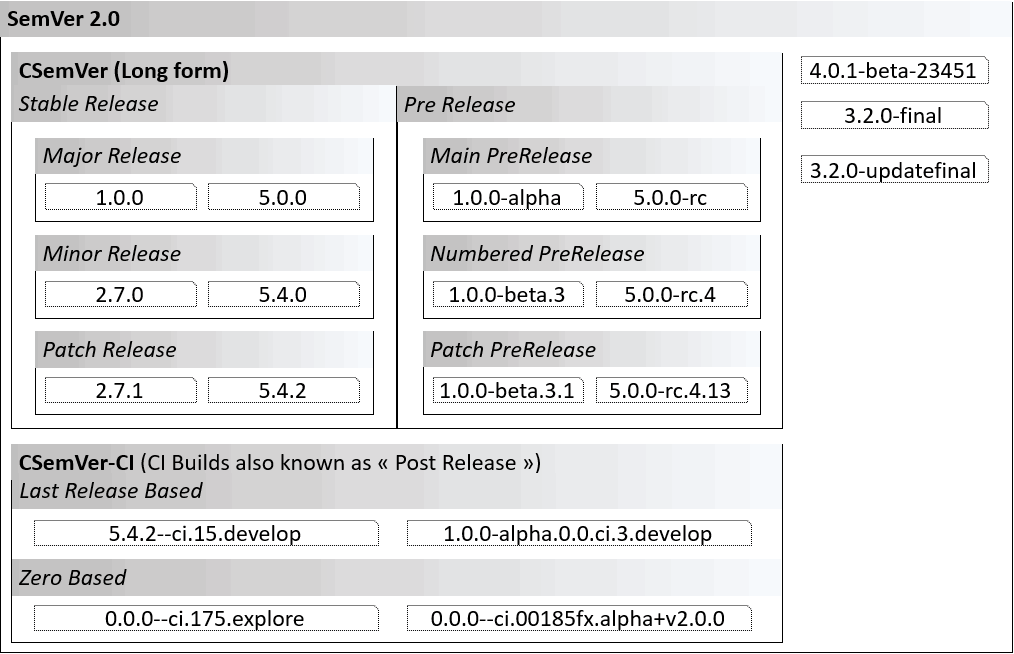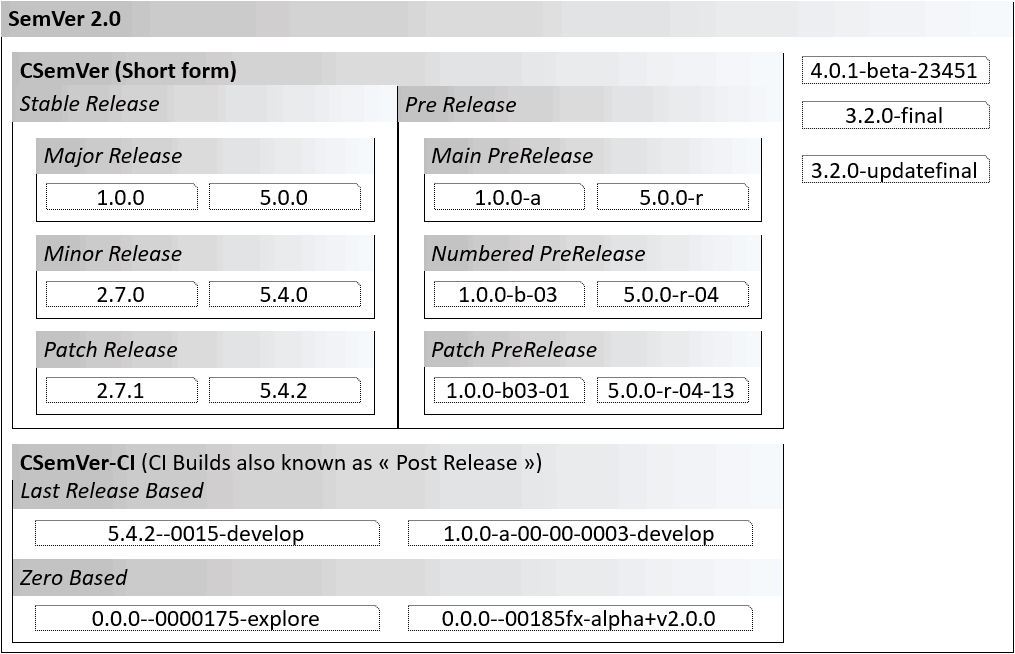

CSemVer is an operational subset of Semantic Versioning 2.0.0 (http://semver.org) that is defined around one strong idea: CSemVer versions are totally ordered, each version corresponds to a unique 64 bits signed integer ranging from 1 (v0.0.0-alpha) to 4000050000000000000 (v99999.49999.9999).
CSemVer-CI is an extension that supports CI builds. Its versions follow SemVer 2.0.0, but are not CSemVer compliant. CSemVer-CI defines 2 kind of CI versions:
CSemVer and CSemVer-CI both offer long and short version forms. The short form is compatible with NuGet V2 version handling and are often considered more readable.


1 - CSemVer defines a totally ordered set of versions. This is used to generate and/or control versions that guaranty a correct application of precedence rules and coherency of the emitted artifacts. Each CSemVer version is associated to a unique integer that fits into Windows binary version number.
| CSemVer | Short form(1) | Ordered Version | Description |
|---|---|---|---|
| v0.0.0-alpha | 0.0.0-a | 1 | The very first possible version is the 0.0.0 alpha (this is a MainPrerelease). There are 27 possible first versions (it can be 0.0.0, 0.1.0 and 1.0.0 with their 8 prereleases). |
| v0.0.0-alpha.1 | 0.0.0-a01 | 101 | These are NumberedPreReleases. There can be 99 NumberedPreReleases for each MainPreRelease. |
| v0.0.0-alpha.2 | 0.0.0-a02 | 201 | |
| v0.0.0-alpha.0.1 | 0.0.0-a00-01 | 2 | Oops! There was a bug in the very first alpha and someone, for any reason, needs a fix. This is a PatchPreRelease. |
| v1.0.0 | 1.0.0 | 40000500080001 | The first Stable Release is a MajorRelease. |
| v1.0.1 | 1.0.1 | 40000500160002 | A fix to the first Stable version: as a PatchRelease, it should contain only bug fixes, no breaking changes. (This is a Stable Release.) |
| v1.1.0 | 1.1.0 | 40001300090001 | Introduction of new features but no breaking changes: welcome to the MinorRelease. (This is a Stable Release.) |
| v2.0.0-rc | 2.0.0-r | 80001000070001 | A MainPreRelease that prepares the next MajorRelease. |
(1) The origin of this Short form is that NuGet packaging system in its V2 version (2015) did not follow Semantic Versioning (the 'special name' - the prerelease part - was simply ordered lexically in ASCII sort order). Moreover this 'special name' could not exceed 20 characters. The latter is the reason why the Short form uses only the initial of the prerelease name (in order to support CSemVer-CI LastReleasedBased versionning).
2 - CSemVer makes possible to really control the versions that are published. The valid successors (according to Semantic Versioning rules) of any version can be computed (there can be up to 28 successors to a version) and, respectively, one can decide whether a version is a valid predecessor of any other version.
| Version | Successors |
|---|---|
| v1.2.3 27 successors |
v1.2.4-alpha, v1.2.4-beta, v1.2.4-delta, v1.2.4-epsilon, v1.2.4-gamma, v1.2.4-kappa, v1.2.4-prerelease, v1.2.4-rc, v1.2.4, v1.3.0-alpha ⇒(2) v1.3.0-rc, v1.3.0, v2.0.0-alpha ⇒ v2.0.0-rc, v2.0.0 |
| v1.2.3-alpha 28 successors |
v1.2.3-alpha.0.1, v1.2.3-alpha.1, v1.2.3-beta ⇒ v1.2.3-rc, v1.2.3, v1.3.0-alpha ⇒ v1.3.0-rc, v1.3.0, v2.0.0-alpha ⇒ v2.0.0-rc, v2.0.0 |
| v1.2.3-delta.5 26 successors |
v1.2.3-delta.5.1, v1.2.3-delta.6, v1.2.3-epsilon ⇒ v1.2.3-rc, v1.2.3, v1.3.0-alpha ⇒ v1.3.0-rc, v1.3.0, v2.0.0-alpha ⇒ v2.0.0-rc, v2.0.0 |
| v1.2.3-prerelease.2.3 22 successors |
v1.2.3-prerelease.2.4, v1.2.3-prerelease.3, v1.2.3-rc, v1.2.3, v1.3.0-alpha ⇒ v1.3.0-rc, v1.3.0, v2.0.0-alpha ⇒ v2.0.0-rc, v2.0.0 |
| v1.2.3-rc 21 successors |
v1.2.3-rc.0.1, v1.2.3-rc.1, v1.2.3, v1.3.0-alpha ⇒ v1.3.0-rc, v1.3.0, v2.0.0-alpha ⇒ v2.0.0-rc, v2.0.0 |
(2) The ⇒ replaces the list of the prerelease names from alpha, beta, delta, epsilon, gamma, kappa, prerelease up to rc.
3 - CI builds correspond to productions that are not actual releases: the version has to be automatically created since no real version exist for them. A CI build is defined by: a BuildIndex that is a number or an identifier that gets bigger for each new build (it is usually a simple integer that is provided by the CI process or a timestamp) and a CIBuildName that identifies the source, the nature, or any other constant key of the build (this is usually the name of the 'branch' in a SCM) .
CSemVer-CI enables the support of CI buils into CSemVer versions with the guaranty of a valid precedence order (in order to secure deployments). The two kind of versions offers two different guaranties:
The table below helps understand how CSemVer-CI LastReleasedBased works.
| Base Version | CI Version (PostRelease) | Immediate successor | Description |
|---|---|---|---|
| v0.4.1-rc.2.1 | 0.4.1-rc.2.1.ci.15.develop | v0.4.1-rc.2.2 |
PatchPreRelease This is the simplest one: by appending a dotted part, the CI version has a greater precedence than its base."Base Version" < "CI Version" < "Immediate successor" is guaranteed here and for the 3 other cases below. |
| v3.2.1-rc.1 | 3.2.1-rc.1.0.ci.15.develop | v3.2.1-rc.1.1 |
NumberedPreRelease It is the "padding" with the .0 here that does the job. |
| v3.2.1-beta | 3.2.1-beta.0.0.ci.15.develop | v3.2.1-beta.0.1 |
MainPreRelease The double 0 padding is required for pre release. |
| v1.2.3 | 1.2.4--ci.15.develop | 1.2.4-alpha |
Stable Release |
The key words "MUST", "MUST NOT", "REQUIRED", "SHALL", "SHALL NOT", "SHOULD", "SHOULD NOT", "RECOMMENDED", "MAY", and "OPTIONAL" in this document are to be interpreted as described in RFC 2119.
CSemVer versions follow Semantic Versioning 2.0.0 rules but adds some constraints to them.
Syntax of a CSemVer MUST be:
[v|V]Major.Minor.Patch[-PreReleaseName[.PreReleaseNumber[.PreReleaseFix]]][+BuildMetaData]
CSemVer versions MAY be prefixed with a 'v' or 'V' (GitHub convention). This is the only extension that is not supported by SemVer.
The Major part MUST be defined between 0 and 99999.
The Minor part MUST be defined between 0 and 49999.
The Patch part MUST be defined between 0 and 9999.
The PrereleaseName MAY be denoted by appending a hyphen and a name that MUST be one of the 8 values of the following list (ordered from 0 to 7): alpha, beta, delta, epsilon, gamma, kappa, pre (or prerelease), rc.
The PrereleaseName's intial MAY be used as a short form: a, b, d, e, g, k, p, r.
Any other name not listed in this set MUST be considered syntactically invalid.
The PrereleaseNumber MAY be denoted by appending a dot and a number that MUST be defined between 0 and 99.
The PrereleaseFix MAY be denoted by appending a dot and a number that MUST be defined between 1 and 99.
The PrereleaseNumber 0 MUST appear only when a PrereleaseFix is specified to denote a fix of a first prerelease (v4.3.2-rc.0.2 is the second fix of v4.3.2-rc).
CSemVer-CI versions follow Semantic Version 2.0.0 rules.
Syntax of a CSemVer-CI ZeroTimed MUST be:
0.0.0--ci.BuildIndex.CIBuildName[+BuildMetaData] where the BuildMetaData SHOULD be the base version.
The BuildIndex MUST comprise only ASCII alphanumerics and hyphen [0-9A-Za-z-] and MUST NOT be empty. It can be purely numeric.
The CIBuildName MUST comprise only ASCII alphanumerics and hyphen [0-9A-Za-z-] and MUST NOT be empty.
BuildIndex MUST increase between builds based on the same base version. It MAY be time based with a fixed format (ie. YYYYMMDD-HHMMSS), be an incremented number provided by the CI process or any other numeric or alphanumeric value as long as it is increasing (either numerically or lexically in ASCII sort order) for each build.
In DSCM like Git or Mercurial this CAN be the maximum number of commits from the commit point up to the parent commit that defines the base version.
Syntax of a CSemVer-CI LastReleasedBased MUST be:
Applied to a vMajor.Minor.Patch version:
Major.Minor.Patch+1--ci.BuildIndex.CIBuildName
Applied to a vMajor.Minor.Patch-PreReleaseName version:
Major.Minor.Patch+1-PreReleaseName.0.0.ci.BuildIndex.CIBuildName
Applied to a vMajor.Minor.Patch-PreReleaseName.PreReleaseNumber version:
Major.Minor.Patch+1-PreReleaseName.PreReleaseNumber.0.ci.BuildIndex.CIBuildName
Applied to a vMajor.Minor.Patch-PreReleaseName.PreReleaseNumber.PreReleaseFix version:
Major.Minor.Patch+1-PreReleaseName.PreReleaseNumber.PreReleaseFix.ci.BuildIndex.CIBuildName
The Constrained Semantic Versioning specification is authored by Signature Code.
If you'd like to leave feedback, please open an issue on GitHub.